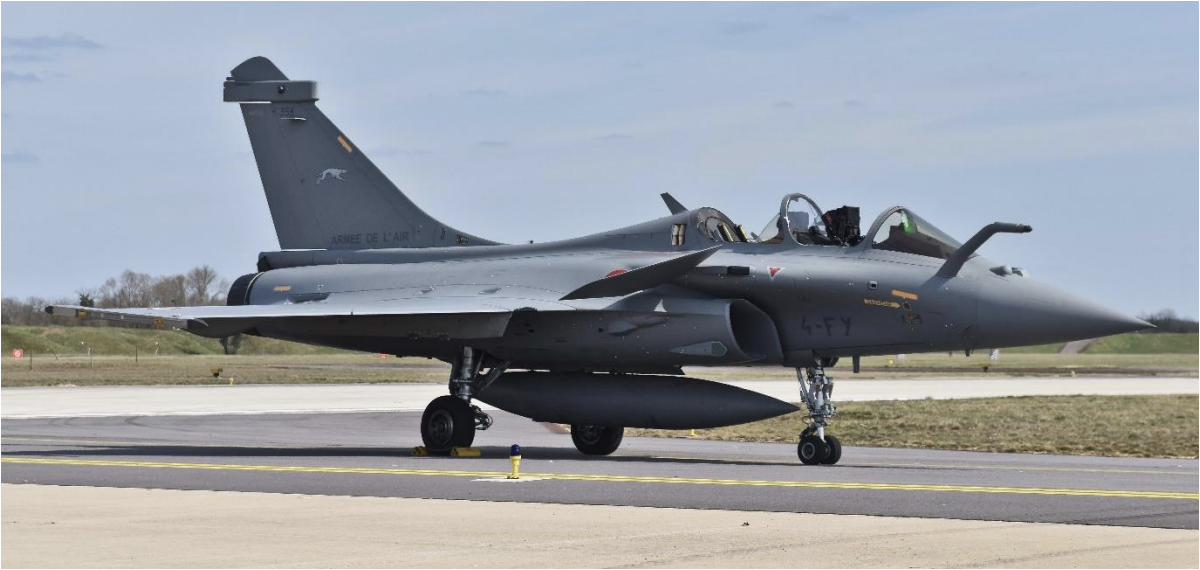
A ride in a French Air Force Rafale B didn’t go as planned when an overstressed back-seat passenger inadvertently ejected from the two-seat fighter, and the aircraft was saved only because of a previously undetected flaw that prevented the pilot’s ejection, a new French military report says.
The back-seat passenger on the March 2019 flight from Saint Dizier, France was a 64-year-old contractor responsible for the test activity of a French armaments company, according to the report published April 6 by the French military’s air accident investigation office.
When the passenger arrived in Saint Dizier the evening before the flight, he was unaware that his colleagues had arranged a special, back-seat ride in the French Air Force’s most advanced fighter, the report says.
His colleagues, who included a former French Air Force pilot, wanted to make the flight a surprise, but they didn’t count on the prospective passenger’s reaction.
The passenger “never expressed a desire to carry out this type of flight and, in particular, on Rafale,” according to a translated copy of the French-language report.
Because the gesture was meant as a surprise, the passenger was informed only hours before the flight, leaving little time for him to prepare. The passenger did not feel he could decline the gesture, bowing to the social pressure imposed by his colleagues, the report says.
A required, preflight medical examination resulted in a recommendation by the doctor to limit any maneuver forces to less than 3gs. An office electronic system failure, however, prevented the doctor’s guidance from being relayed to the passenger or the pilot of the Rafale involved in the mishap, the report says.
The hastily-arranged surprise also meant that the passenger had to hitch a ride on whatever flight was already arranged on that day, which was a routine patrol mission by three aircraft. Such missions include a standard climb immediately after takeoff with loads greater than 4.5gs, the report says.
The passenger appeared enthusiastic to the pilot as he climbed into his cockpit, but there were signs that he was overstressed. The passenger’s wristwatch recorded his heart beats per minute. The maximum heart rate for a man of his age is 156 beats per minute, according to the report. His was racing from 136 to 142 as he seated himself.
Perhaps due to the stress, the passenger failed to properly buckle in. The back side of his shoulder strap allowed more motion than necessary, the report says. In addition, he didn’t fasten the right leg of his pressure suit, lower the helmet visor or snap the chin strap of his helmet.
The passenger’s experience in the back seat of the Rafale would be brief.
As the pilot rotated on takeoff, the Rafale rapidly developed aerodynamic loads over 4.5gs. Within about 10 sec. of rotation, the pilot leveled off quickly, causing the loads to invert to negative 0.63gs. The shocked passenger, whose loose shoulder straps may have allowed him to start floating upward, reached for a handle, which happened to be the mechanism that causes his seat to eject.
Because the passenger had failed to lower his visor and fasten his chin strap, the exposure to the 200-kt. air flow outside the aircraft caused his helmet to fly off, the report says. Besides minor injuries to his face, the passenger landed safely by the runway after his parachute opened at around 2,000 ft.
The passenger’s inadvertent ejection command could have been disastrous for the aircraft. The two-seat version of the Rafale allows the pilot to select between two options: “1” allows only a single seat to eject when one handle is pulled, and “2” commands both seats to eject when only one is pulled. The pilot had selected the “2” option for this flight, the report says, meaning the pilot’s seat was also supposed to eject.
The ejection sequence proceeded normally, with the canopy of both seats shattering and the back seat firing. However, the explosive charge connected to the front seat never received a command to fire, the report says. As a result, the pilot remained on board the aircraft, albeit with a missing canopy and back seat. The pilot dumped fuel and returned to Saint Dizier to land, the report says. The aircraft was secured for 24 hr. until the front seat’s explosive charge could be disarmed.






Comments
There are just so many.
Are we to take this as an indication of the reliability level of the Rafale's life critical software? More reporting by AW would be greatly welcome on this topic.